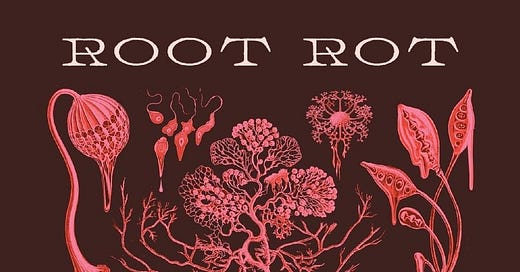Read as an ARC from Netgalley (nobody told me it wasn’t Netgallery with an r! Guys! I’ve been saying and typing it as Netgallery for weeks)
Root Rot is a strange little book. The decision to have it narrated from a child’s perspective makes the book; the narration has an innocence to it that I thought made the horror of the book feel more concrete and pressing; the balancing of children and horror is a difficult one to manage, but it works well here. There’s notions of quiet resentment and passive familial strife, but we’re only party to the limited perspective that children are often relegated to.
The names of the siblings — The One Who Runs Away, The Liar— are reminiscent of the names of years in Susanna Clarke’s Piranesi, and in Root Rot they act as a reminder of both the children’s age and their tendency to attribute characteristics to people that stick. It speaks to the way they make sense of the world — which again, reminded me of Piranesi.
The scenes read as though they’re fragments from a dream you had once where everything was fleeting and shifting and you can’t remember much of it but it left a bad taste in your mouth. They’re done exceptionally well; they feel tangible in the sense that they’re not entirely too absurd, but not rooted in reality enough to be normal, just on the edge where they send a shiver down your spine.
I do think it would have benefitted from a few less characters; it jumbles things and makes it hard to keep up with who’s who. Perhaps this was the point, but I would have liked to follow a few concrete characters formed better, and I think it would have made the story a bit more comprehensible, but it wasn’t something that ruined it for me. There is no single identified narrator, but as if the narrator is speaking for all the children, which is confusing, but I think it’s best if you let it be confusing.
You do get a better sense of The Liar as the book goes on, namely that she’s not cis (I think; it’s not too clear, but I think she’s trans), and I thought the parts where we get a glimpse into her relationship with the other children and her own parents and also her self consciousness made her character a bit more fleshed out.
The language and writing is clear, but the story is disconnected, and this creates a contrast that works quite well to portray this dream-like, fleeting and forgetful world in Root Rot.
This is one of those books that trying to decipher would be in vain and perhaps ruin it — you have to let it be what it is. It won’t be for everyone, because it’s disjointed and non-linear and I think this kind of magical realism horror is an acquired taste, but if it sounds interesting, give it a read!
A list of books it reminded me of, in one sense or another: Sorrowland by Rivers Solomon, Woodworm by Layla Martínez, This Is How you Lose the Time War by Amal El-Mohtar & Max Gladstone, What Moves the Dead by T. Kingfisher, The Ghostwoods by C.J Cooke. If you enjoyed any of these, I’d highly recommend Root Rot — it comes out March 25th!
A few things:
Small announcement coming soon re: the future of haunting the staircase, but wanted to get this review out in lieu of a monthly roundup because all I read in January besides Root Rot was Swan Song
Reminder to read books by Black authors this month and also every other month
That’s all for now, take care of yourself





Sounds right up my alley!